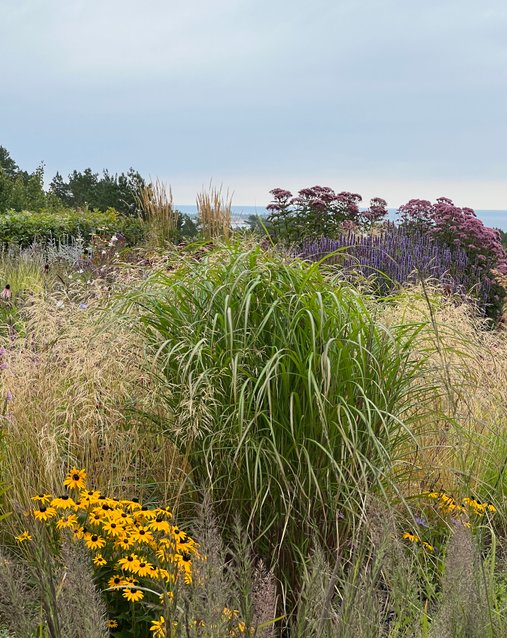Naturalistic gardens
Naturalistic garden design has its roots back to the 19th century, and has since developed in various directions. The most known, and undoubtedly most popular, is the one often referred to as "the New Perennial movement". The renowned Dutch garden designer Piet Oudolf is considered to be the originator of this movement. Among others, he has designed the garden that surrounds the High Line in New York, Lurie Park in Chicago and the "Open field" associated with the gallery Hauser & Wirth in Somerset.
"My biggest inspiration is nature;
I do not want to copy it,
but to recreate the emotion"
Piet Oudolf
The quote above embraces the essence of what naturalistic gardens seek to achieve: To recreate the same feeling that one can sometimes experience in nature: A distinctive harmony, which gives a deep resonance in our own nature.
Naturalistic gardens have qualities that touch both aesthetically and emotionally. Surrounding yourself with such a garden, and following the development through the four seasons is really a great joy. In recent years, Piet Oudolf has prioritised to design public gardens, so that as many people as possible have the opportunity to see and experience them.
What are the characteristics of naturalistic gardens?
As mentioned, imitation of nature is central, and meadows and prairie landscapes are the most used models. Common denominators are the extensive use of (ornamental) grass and plants / flowers that are similar to the flora we find in nature, both in terms of shape and structure of foliage and flowers. The placement of plants is also inspired by nature; you plant densely and let the plants weave into each other.
It is important to ensure a balance in the complex mix of plant species, so that the eye finds rest and you achieve the harmony you are looking for. Although naturalistic plantings may seem random, they are carefully designed. One usually plant in groups or in a more advanced "matrix", and use different design principles to create variety and coherence.
Plants with a structure that lasts, even after flowering is over, are essential. Seedheads and ornamental grasses make the gardens a beautiful sight during also during winter. Nothing is cut down until towards the beginning of Spring.
Which surroundings fit these plantings?
This garden style fits into most surroundings. As a smooth transition to the surrounding nature or as an exciting and soft contrast to strict architecture -In small or large gardens, at the summer cottage, in parks, on roof terraces -You can create a naturalistic oasis wherever it is possible to make something grow, to the great joy of both people and biological diversity.
Plant Choices
Local, wild-growing plant species (or cultivars of these) are often included in naturalistic planting designs. In traditional nature gardens, one often confines oneself to only local species, while within this style, plant varieties from all over the world may be used. The main criteria is that the individual species fits into the whole, in terms of design, behaviour and robustness.
It is important that the plants provide interest over time (before and/or after flowering), and contribute to biological diversity, especially with regard to pollinators and other wildlife.
Some reflections
- Think big! Perhaps some of the lawn can be turned into a planting area? It will definetely bring joy not just to you and your visitors, but also to an abundant amount of insects, pollinators and other living creatures!
- Challenge your preferences when it comes to flower varieties and colors. Then there will be even more to enjoy!
- Consider the soil and light conditions in your garden, but feel free to stretch the boundaries a tiny bit. It may work!
- It is wise to prepare for the climate changes, which point in the direction of increasing periods of heavy drought and rainfall accordingly. Prioritise drought-tolerant plants - and consider to create a rain garden bed too.
- Try sowing your own plants. It offers much more possibilities both in terms of selection and of getting many plants at an affordable price. All it takes is being patient and giving them care while they mature. It may take an extra season or two, but in return, they will forever be your "babies".
- Get to know your plants. Trial and error makes you learn - and succeed! It is an exciting journey, even though failures and disappointment may be a part of the process too. Gardening teaches us about patience and acceptance and invites us to lower the joy-killing perfectionism and focus on the bigger picture instead.
Recommended Books
- Planting the Natural Garden
Piet Oudolf/Henk Gerritsen - Planting: a new perspective
Piet Oudolf/Noel Kingsbury - Tiny and Wild - Build a small-scale meadow anywhere
Graham Laird Gardner - The Know Maintenance Perennial Garden
Roy Diblik - Planting the Oudolf Gardens at Hauser & Wirth, Somerset
Rory Dusoir/Piet Oudolf - Naturalistic Planting Design
Nigel Dunnett
Most books have plant directories - very useful!
More inspiration?
(Click the links below).
- Lurie garden, presented by Piet Oudolf - highly recommended!
- Lurie garden, Millenium Park, Chicago
- Scampston Walled Garden, design by Piet Oudolf
- Pictures from "Open field" Houser & Wirth, Summer (photograph Jason Ingram)
- Pictures from "Open field" Winther (photograph Jason Ingram)
- Nigel Dunnetts webpage. Great photos and knowledge sharing from his projects
- Tony Spencer´s rich and inspiring site about naturalistic planting design
- Beth Chatto´s gardens


